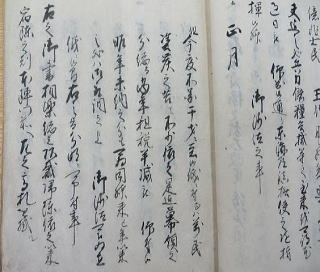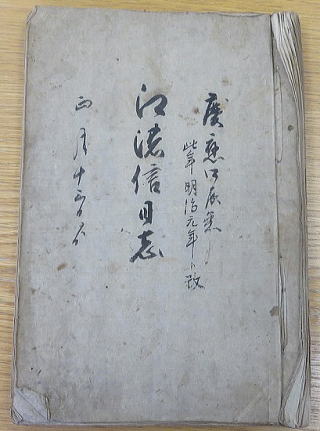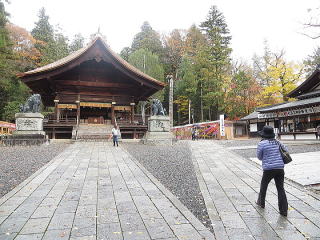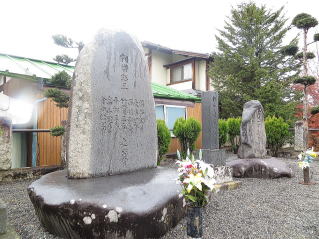| |
|||||||
| 謀略体質の東山道軍(西軍・のちの明治新政府軍) 赤報隊斬殺 小栗主従殺害の前に信州下諏訪で「ニセ官軍」として赤報隊8名を斬殺してきた The Tosando Army (Western Army, later Meiji New Government Army) with a scheming constitution Cruel Murder of Sekihotai Members Before the murder of Kozukenosuke Oguri and his retainers, the Tosando Army cruelly murdered eight members of the Sekihotai in Shimosuwa, Shinshu (today's Nagano prefeture) , calling them as a "fake government army." |
|||||||
| 下諏訪で赤報隊八名を斬殺 Eight members of the Sekihotai were slain in Shimosuwa by the Tosando Army. |
|||||||
| ◆赤報隊は、西軍への協力先触れ隊 1868慶應四年一月、西郷隆盛や岩倉具視の支援を受け新政府の許可を得て東山道軍の先鋒隊として一番隊隊長相楽総三、二番隊、三番隊と、赤報隊が結成された。公家の綾小路俊実、滋野井公寿らを盟主として、中山道の沿道各地で「年貢半減」を触れ、西軍への賛同協力を呼びかける「嚮導先鋒」を命じる太政官の坊城大納言名の勅書を得て、先頭は和田峠を越え碓氷峠まで進んだ。 その頃、朝廷は「年貢半減」は実行不可能で新政府の財政が立ち行かなくなるとして、早くも一月末にこれを取り消していた。そして東山道軍は赤報隊を「ニセ官軍」とし、軍議を名目に相楽総三らを下諏訪へ呼び戻して捕え、諏訪大社秋宮の木に縛って一晩ミゾレの氷雨にさらし、翌日三月三日夕刻、取調べをしないまま「ニセ官軍」の罪名をもって部下七名とともに斬首した。 ◆ Sekihotai was the first to cooperate with the West Forces. In January 1868, with the support of Takamori Saigo and Tomomi Iwakura, and with the permission of the new government, the Sekihotai was formed as the spearhead of the Tosando Army, which consisted of the First Corps, captained by Sozo Sagara, as well as the Second and Third Corps. Allied with the court nobles Toshizane Ayanokoji and Kinhisa Shigenoi, they went around to various places along the Nakasendo route, asking for a "reduction of annual tribute by half" and, after receiving a royal warrant from the Grand Council of State in the name of Dajokan Bojo, ordering them to "lead the way" and call for support and cooperation with the West Army, they advanced at the head of the line over the Wada Pass to the Usui Pass. At that time, the Imperial Court had already canceled the "reduction of annual tribute by half" as early as the end of January, on the grounds that it was unfeasible and the new government would not be able to maintain its finances. The Tosando army then declared the Sekihotai to be a "fake government army," and under the guise of a military meeting, called Sozo Sagara and others back to Shimosuwa, captured them to tie them to trees at the Akimiya Shrine of Suwa-taisha Shrine and exposed them to the freezing rain overnight. The next day, on the evening of March 3, Sozo Sagara was beheaded without interrogation, along with seven of his subordinates, under the charge of "false government forces." |
|||||||
  |
|||||||
▲『江濃信日誌』に「年貢半減」を記載 (下諏訪町立博物館蔵) ▲ The "Gohnohshin Nisshi (Diary of Gohnohshin)" describing "half tribute" (collection of Shimosuwa Town Museum) The "Gohnohshin Nisshi (Diary of Enoshin)" of the first group that served in the Ohmi (today's Shiga prefecture), Mino (today's southern part of Gifu prefecture), and Shinshu (today's Nagano prefecture) areas records the "Order to Reduce the Annual Tribute by Half" that was announced wherever they went. It was also displayed on a takafuda* in front of the main camp in Shimosuwa. * It was a board erected in front of the gates of temples and shrines and in busy places in the medieval and early modern periods of Japan to write down prohibitions, laws, written rules, and criminal charges.
|
|||||||
 |
|||||||
▲諏訪大社秋宮 |
|||||||
| 相楽総三は「薩摩強盗」の頭だった Sozo Sagara was a head of "Satsuma Bandits." |
|||||||
|
◆相楽総三はもと薩摩強盗の頭 相楽は江戸赤坂に生まれ、本名は小島将満。国学と兵学を学び、若くして私塾を開いて多くの門人を抱え、23歳の時に尊王攘夷活動に入る。 ◆ Sozo Zagara was previously a head of Satsuma Bandits. Sozo Sagara was born in Akasaka, Edo, and his real name was Masamichi Kojima. He studied ancient Japanese thought and culture and military science, opened a private school at a young age and had many students, and at the age of 23, he began to engage in activities of the sonnoh-joi movements (19th century movements advocating reverence for the Emperor and the elimination of foreigners). In early October 1868 (3rd year of Keio), Kyunosuke Masumitsu and Shohei Imuda both of Satsuma clan and Sozo Sagara (Masamichi Shiro Kojima), moved from Kyoto to Edo and entered Satsuma Yashiki residence (the Satsuma clan's residence) in Mita. This move was made in response to the desire of Takamori Saigo and Toshimichi Okubo, who had lost their momentum for overthrowing the shogunate due to Yoshinobu Tokugawa's Taisei-Hokan (transfer of power back to the Emperor), to provoke the shogunate and start a war against the shogunate. With Satsuma Yashiki residence as their stronghold, they gathered about 500 ronins (masterless samurais) and repeatedly committed arson, assault, murder, and plunder, and were known as "Satsuma Goyoto (Satsuma Bandits)," which horrified the people of Edo.
"In the Edo area, several hundreds of ronins from Kanto such as Sagara and Nakamura, were hiding in the Satsuma Yashiki residence in Mita, and every night they formed a gang and robbed the wealthy people of the city, carrying guns, in order to raise money for the war effort." This is taken from "Katsuhaku Jiseki, Kaijo Shimatsu (The History of Katsuhaku and the Opening of the Castle by Takeshi Sakazaki)." [From "Sozo Sagara and His Comrades" by Shin Hasegawa p. 231] "The ronins who gathered at the Satsuma Yashiki residence also admitted to the robbery. 'One night, several ronins were sent to attack Shin'emon Harimaya, the Shogunate's official merchant. The ronins reached Kanefuki-cho, closed the wooden doors at the front and rear (each town had gate fences at this time, called a machikido, and Kanefuki-cho was in the Nihonbashi district in Edo), entered the Karamono store (which buys and sells miscellaneous goods imported from China and other foreign countries), took several dozen six-shooters, and rushed into the Harimaya store. The family was terrified and did not know what to do. The ronins called the head clerk and said that the people of the store have always known the existence of the Shogunate, but they have never known what the loyalists are, and their crime is not so small. If they repented of their previous wrongdoings, they are requested to donate military funds to the camp of the loyalists, and the head clerk bowed many times and agreed to do so. Two apprentice boys guided the ronins to the cellar and gave them 18,000 ryo in gold.' This is a scene from "Satsutei Jiken Ryakuzu (A Brief Account of the Satsuma Yashiki Incident)." [From "Sozo Sagara and His Comrades" by Shin Hasegawa p. 232] 『晦結溢言』にも強盗のことがある。「庄内藩巡邏の一人なる山下英蔵の直話に、本郷追分に高崎屋と云ふは、時節柄戒心して、夜は店舗を角材格子作とし、固く鎖して二階に警鐘を釣りたり、然るに、多人数押掛け榔槌かけやを以て打破り、闖入ちんにゅうしたる故、警鐘を鳴したれば、近傍より馳集るに、忽ちその両三人を斬殺し、高崎屋の家族七人を殺して、金銀を悉く奪ひ去る」ここまででは強盗が薩邸の浪士だと断定してゐないが、その後に、「十二月十八日、浅草市の日なりしが、薩邸潜伏の巨魁三名、品川のドド相模(注・土蔵相模の誤り)に遊蕩すと聞き、直ちに逮捕に向ひたるに、二人取逃し、一人切捨、確證を得、尚精査するに愈相違なし」とある。【長谷川伸『相楽総三とその同志』p233より】 There is also a reference to robberies in "Kaiketsu Itsugon." "Eizo Yamashita, one of the Shonai Domain's patrolmen, told me in person that there was a store called Takasakiya in Hongo Oiwake, which was guarded at night by a latticework of square timbers, tightly chained and with an alarm bell hung on the second floor. When a large number of robbers broke through with hammers and entered the store, the alarm bell was sounded and people rushed to the store from the neighborhood, but the robbers suddenly killed three people, killed seven members of the Takasakiya family and robbed the shop of all its money." The robbers were not identified as ronins from the Satsuma Yashiki residence until this point, but later, the following was written. "On December 18, the day of the Asakusa market, they were told that three of the great gangsters hiding in the Satsuma Yashiki residence had gone to Dozo Sagami in Shinagawa to engage in debauchery and they immediately went there to arrest them. Two were eluded and one was cut down, and upon further examination, there was no doubt that these men were the ones who attacked the Takasakiya." [From "Sozo Sagara and His Comrades" by Shin Hasegawa p. 233] 慶応三年十二月二十五日、強盗団の根拠地となっている三田の薩邸が幕府によって焼き討ちされた時、 On December 25, 1868 (3rd year of Keio), the shogunate burned down the Satsuma Yashiki residence in Mita, where the robbers had their base of operations and, about this insident, there is the following information: In the "Nanki-Tokugawa-shi (History of Nanki Tokugawa)," it is said that one of the two who escaped in a palanquin from Shinagawa on the same night was a certain Ito, who later became a naval officer. It is also said that the man, who was a palanquin carrier on the night and is now working for the people of the Imperial Household, said, 'the man was a night burglar.' [From "Sozo Sagara and His Comrades" by Shin Hasegawa p. 234] 「総裁相楽総三が水原二郎(落合直亮)と、浪士約二十人をつれて柳橋に遊んだことがある。芸者を多勢呼んで大盤振舞ひをやるうちに、刀を抜いて剣舞するものなどが出て、芸者達は駭おどろいて逃げ出した。その帰りは水路をとり、船の中から水鳥を射ちなどした。そのころ江戸府内での発砲は厳禁だったから町同心などが吃驚し駈けつけたが、咎むる者がなかった。この船に陸から尾行したものがあって、薩邸に相楽・水原等がはひったのを見届けた。」【長谷川伸『相楽総三とその同志』p246より】 "Once, Sozo Sagara, the leader of the group, took Jiro Mizuhara (Naoaki Ochiai) and about 20 ronins (masterless samurais) to Yanagibashi. They invited many geishas to join them for a grand performance, during which some of them pulled out their swords and performed a sword dance, which made the geishas horrified and run away. On their way back, they took the waterway and shot water fowls from inside their boats. At that time, shooting was strictly prohibited in Edo, so the town's social order maintenance officials and others were startled and rushed to the scene, but no one was arrested. A man followed the ship from land and saw that Sagara, Mizuhara, and others were arriving at the Satsuma Yashiki residence." [From "Sozo Sagara and His Comrades" by Shin Hasegawa p. 246]
This largesse for entertainment was, of course, money obtained through robbery and murder. The Satsuma clan did not provide living expenses, allowances, and entertainment for the 500 or so ronins. They were self-righteous and self-sufficient robbers who obtained their living and entertainment expenses by threatening to provide funds to support their imperialism movement, and sometimes even by murder. ◆一石二鳥の赤報隊殺害 【長谷川伸『相楽総三とその同志』p385より】
On December 25, 1868 (3rd year of Kaio), the shogunate and the Shonai Clan, which controlled the city of Edo, burned down the Satsuma Yashiki residence. Sagara escaped in the Satsuma Clan's Shohomaru and entered Kyoto, where he formed the Sekihotai under the direction of Takamori Saigo and Tomomi Iwakura. Takamori Saigo was delighted: 結局、赤報隊は8人が下諏訪で東山道軍によって斬殺されてしまう。相楽は時に29歳であった。この処分で明治新政府は、一石二鳥で この品性に劣る謀略体質に満ちた西軍・東山道軍が次に碓氷峠を越え高崎まで来て行ったのが、小栗父子主従8人の殺害と家財没収・入札で売却し軍資金として持ち去るという、やはり品性劣る強盗殺人行為。 In the end, eight members of the Sekihotai were slain in Shimosuwa by the Tosando forces. Sagara was 29 years old at the time. With this disposition, the new Meiji government killed two birds with one stone. They have dealt with the following two things surreptitiously without the public knowing: The West and Tosando forces, filled with a scheming spirit of inferior character, crossed the Usui Pass to Takasaki, where they committed the murder of the Kozukenosuke Oguri, his son and his retainers, confiscated their household goods, and sold them at auction to be used as funds for the war effort. The common point is that they were all killed as rebels without interrogation. The difference is that Kozukenosuke Oguri, the father of Japan's modernization, is still treated as a traitor today, while Sozo Sagara, who was the head of a former gang of robbers and murderers under the direction of Saigo and Iwakura, was awarded the title of "Restored Honor" for his contribution to the Meiji Restoration in 1928. ・関係者: 東山道総督岩倉具定(17歳・岩倉具視の二男)、副総督岩倉具経(16歳・岩倉具視の三男八千丸)、参謀土佐・乾退輔(のちの板垣退助伯爵)、薩摩・伊 Persons involved: Tomosada Iwakura (17, Tomomi Iwakura's second son), Governor-General of Tosando Province; Tomitsune Iwakura (16, Tomomi Iwakura's third son, chilehood name of Yachimaru), Deputy Governor-General; Taisuke Inui (later Count Taisuke Itagaki), Chief of Staff from Tosa; Masaharu Ijichi (later Count) from Satsuma; Ritsuen Uda (Iwakura family retainer); Yasutaro Hara (22), Military Inspector; Kan-ichiro Toyonaga (17); Ryotaro Ohto (24). ・原保太郎:「処刑立会ひの原保太郎は丹波篠山の人で、剣道ができるので、京都に出てゐる間に岩倉具視に知られ、岩倉兄弟が東山道鎮撫総督副総督で東下するにあたり、側人となって随行した。原にいはせると「用心棒だよ」である。時に原は二十二歳、(原の談話筆記に『文久三年十六歳、江戸に出た』とある。それだと一歳の違ひが出来る)、原の説では、「富永〈豊永〉貫一郎は少年で、そのころ十六ぐらゐだ」とある。此の原・富永〈豊永〉は追分の処刑に関係しただけではなく、〈閏〉四月六日(おなじ年の慶應四年)上州の権田村烏川の河原で、小栗上野介等を死刑に行ったときも、立会人であるだけでなく、原は自分の刀で上野介を斬った。この調子から推して想像すると、相楽総三ら八人の死刑執行の立会人も、原・富永〈豊永〉ではないかといふ事になり易い。」【長谷川伸『相楽総三とその同志』p615より】( )は筆者長谷川伸、〈 〉は村上泰賢が補った。 Yasutaro Hara: "Yasutaro Hara, who witnessed the execution of Sekihotai members, was a native of Tamba-Sasayama. He was known to Tomomi Iwakura during his stay in Kyoto because of his kendo skills, and he accompanied the Iwakura brothers on their journey east as deputy governor-general of the Tosando Province. Hara says, 'I was a bouncer.' Hara was 22 years old at the time (According to written accounts of his conversation, however, he left for Edo at the age of 16 in the 3rd year of Bunkyu. If that was the case, there is one year difference). Hara's account says that Kan-ichiro Tominaga <or Toyonaga> was a teenageer, about 16 years old at the time. Hara and Tominaga <or Toyonaga> were not only involved in the execution of Sekihotai members at Oiwake, but also witnessed the execution of Kozukenosuke Oguri and others on <leap> April 6, 1868 or Keio 4 at the banks of the Karasugawa River in Gonda Village, Jyoshu or today's Gunma Prefecture, where not only was he present, but he also slashed Kozukenosuke Oguri with his own sword. Based on this, it is easy to imagine that Hara and Tominaga <or Toyonaga> were also witnesses at the executions of eight men including Sozo Sagara." [From "Sozo Sagara and His Comrades" by Shin Hasegawa p. 615] The author, Shin Hasegawa, supplemented the portion of ( ) and Taiken Murakami supplemented the portions of <>. * Regarding the underlined part, "Hara also slashed Kozukenosuke Oguri with his own sword," there is a theory that Gorosaku Asada, a samurai of the Annaka Clan, did the slaying. It is inconceivable that Yasutaro Hara, the military supervisor, who witnessed the event would have done it himself. Hara replied, "Itagaki, the chief of staff, ordered me to dispose of him severely, and I did so in accordance with his order. [From “Ishin Shokan” by Shin Ninagawa, p248.] ・大音龍太郎おおとりょうたろう:「近江(滋賀県木之本町大音おおと・賤ケ岳の南東麓)の出身で、京都で勉強中に岡本黄石に知られ、上州箕輪の龍門寺牧野再龍といふ奇警な人物に預けられたのが十六の時だった。牧野再龍は越後出身の勤王僧だから、その鼓吹をうけ、性根が出来たのである。大音は京都にのぼり、岩倉具視の知遇をうけ、今度も岩倉兄弟に随って来てゐた。 Ryotaro Ohto: "Ryotaro Ohto was from Ohmi (Ohto area, Kinomoto-cho, Shiga Prefecture at the southeastern foot of Mt. Shizugatake). While studying in Kyoto, he was known to Kouseki Okamoto, and at the age of 16 he was entrusted to an eccentric person named Sairyu Makino of Ryumonji Temple in Minowa, Joshu or today's Gunma Prefecture. Makino was a loyal Buddhist monk from Echigo (today's Niigata Prefecture), and it was under his inspiration that his character was formed. Ohto went to Kyoto, received the favor of Tomomi Iwakurai, and again followed the Iwakura brothers. The end of the Tokugawa Shogunate's history was marked by several bloody events. One such event was the slaughter of six <eight> of Kozukenosuke Oguri, the most prominent war theorist of the old shogunate, and his followers, in the village of Gonda in the Haruna Mountains of Jyoshu. Ohto was a person involved in the slaughter. Ohto was the first governor of Iwahana Prefecture, which was established before the establishment of Gunma Prefecture, and his administration was so severe that a person who stole a square of wheat was put to death, and some were put to death because of bad rumors. Perhaps for this reason, he was removed from office after only seven months. During the Satsuma Rebellion, Ohto secretly plotted with Munemitsu Mutsu and others for the Satsuma Army. Mutsu was once imprisoned, but after the release, he took on the burden of the difficult situation of Meiji diplomacy and became known as the "Minister of Razor." On the other hand, Ohto, who hid in a mountain temple in Jyoshu and was never caught, became a country calligrapher with a broken hakama. There were several people who saw him on his travels. On November 23, 1912, he passed away in Tokyo at the end of his sixty-eight years of life." [From "Sozo Sagara and His Comrades" by Shin Hasegawa p. 568] Taiken Murakami supplemented the portion of <>. ・龍門寺(現在高崎市箕郷町東明屋・曹洞宗): は江戸の初めに箕輪城主となった井伊直政の菩提寺であり、井伊家が高崎に城を構えて移り、さらに彦根に移ってのちも彦根とのつながりはあったから、大音龍太郎が近江から上州の龍門寺に来たのもそういった縁からと思われる。
◆ 謀略体質 【長谷川伸『相楽総三とその同志』より】*( )は村上泰賢が補った ◆ The nature of conspiracy The Satsuma bandits were described by Yoshinaga Matsudaira (Shungaku Matsudaira), the former lord of Echizen Fukui, in his "Itsuji Shiho (Supplement to the History of Events)," written during the Meiji era (1868-1912). "Before the new Imperial Government was established, Lord (Tomomi) Iwakura, (Toshimichi) Okubo, (Takamori) Saigo, and others, on their own initiative, sent word to the Satsuma people in Edo to riot their men and move the soldiers of Saemonnojo Sakai (lord of the Shonai domain) and others to provoke the Tokugawa bannermen in Edo to anger, but it is difficult to know. I believe it to be true, even if the truth in this area is probably difficult to reveal. A fate is a strange thing indeed. While Tomomi Iwakura was behind the Satsuma Bandits that Shiro (Shiro Kojima = Sozo Sagara) was involved in, as Yoshinaga Matsudaira said, Tomosada Iwakura (17 years old) and his brother Tomotsune Iwakura (16 years old) were also behind the murder of Shiro when he was executed and his head was put on public display. [From "Sozo Sagara and His Comrades" by Shin Hasegawa] Taiken Murakami supplemented the portions of ( ).
この時、土佐の乾退助(板垣退助)も江戸騒乱を謀ったが、計画だけで実行まで至らなかった。
"Power tends to corrupt. Absolute power corrupts absolutely." (John Acton, historian) The corruption begins with lying and then proceeds to conspiracy to cover up the lies. And intrigue is accompanied by violence. Even in the case of the "Order to Reduce the Annual Tribute by Half," Saigo and others gave only verbal instructions and did not hand over any official documents. The Meiji government started with the lies of the "fake imperial edict to overthrow the shogunate" and the "fake Nishikibata (Imperial Standard)," and, for the next 77 years, it continued to conduct war after war with lies and intrigue, until finally two atomic bombs were dropped on Japan. If the third bomb had been dropped directly over Tokyo Station, the country would have been destroyed. |
|||||||
 |
|||||||
▲相楽塚(魁(さきがけ)塚 )▲ Sagara-zuka Mound (Sakigake-zuka Mound)
斬殺された場所に8人を供養する魁塚が明治三年に立つ。取り調べなしで殺された人たちを憐れむ気持ちはわかるが、「薩摩強盗団」の前歴に触れないで、明治維新の功労者として「昭和3年に子孫らの努力で贈位され名誉回復」、とするのは納得し難い。 The Sakigake-zuka Mound was erected in the third year of Meiji (1868) as a memorial to the eight people who were slain. Although it is understandable to feel pity for those who were killed without any interrogation, it is difficult to accept that they were "honored in 1928 through the efforts of their descendants" as people who contributed to the Meiji Restoration without mentioning their previous history as "Satsuma Bandits." |
|||||||
| |
|||||||
| 関連ページ ◆赤報隊隊長、処刑!(リンク) ◆相楽総三の無念(リンク) ◆偽官軍の名で殺された美濃博徒・水野弥三郎(リンク)…相楽総三らの前二月に、同じく大垣で騙し討ちされた ◆悪者にされた勤王博徒・黒駒勝蔵(リンク) ■官軍意識とのたたかい・・・明治以来始まった「官は正しい」という錯覚が明治元年から77年間戦争続きの日本をつくった |
Related Pages ◆Execution of the Sekihotai Captain! (link) ◆Sozo Sagara's regret無念 (link) ◆Mino gambler Yasaburo Mizuno, killed in the name of fake government forces (link): He was tricked and killed in Ogaki in February 1868 before Sozo Sagara and others were killed in March. ◆Katsuzo Kurokoma, a loyalist gambler who was demonized (link) ■ The Battle Against Government Consciousness: The illusion that "the government is right" that began in the Meiji era created a war-ridden Japan for 77 years from 1868, the first year of the Meiji era, to the end of WWII in 1945. |
||||||